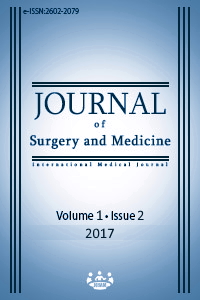A challenging breast cancer type; Differentiation to neuroendocrine tumors
Keywords:
Breast cancer, Neuroendocrine tumorAbstract
Aim: Neuroendocrine type breast carcinomas are rarely observed. Most of these tumors are seen as cell-differentiated neuroendocrine breast carcinoma but with all this infrequency, there is also a rarer type which is called as pure neuroendocrine breast carcinoma. The common locations for neuroendocrine tumors are lung and gastrointestinal system (stomach and pancreas). Although estimations vary, the annual incidence of clinically significant neuroendocrine tumors is approximately 6.5-5 per 500,000; two thirds are carcinoid tumors and one third are other neuroendocrine tumors. The estimated prevalence is 35 per 100,000. In this article, we analyze the patients admitted with breast problems and had the diagnosis of breast cancer with neuroendocrine differentiation or purely neuroendocrine tumor.
Methods: Retrospective cohort study is designed to review neuroendocrine breast cancer patients. Female patients with pathological examination which have neuroendocrine components in neoplasm were reviewed. Demographics, preoperative imaging, diagnostic evaluations, operation and pathological examination records of patients were recorded.
Results: Neuroendocrine breast cancer was observed in 11 patients in study period. All patients received standard therapy like non-specific breast cancer. Only two of 11 patients (18%) were diagnosed with neuroendocrine differentiation in preoperative period by biopsy. One patient received neoadjuvant treatment. Modified radical mastectomy was performed in eight patients (72.8%). Breast conserving surgery was performed in remaining three patients.
Conclusion: Neuroendocrine breast cancer is rare entity, and diagnose at preoperative period may be challenging. In most cases the correct diagnosis is made after proper examination of the postsurgical specimen. Future studies for specific treatments would be of interest.
Downloads
References
WHO (2003) In: Tavassoli FA, Devilee P (eds) World Health Organization classification of tumours. Pathology and genetics of tumours of the breast and female genital organs. IARC Press, Lyon, pp 9–112
Ellis IO, Schnitt SJ, Sastre-Garau X, Bussolati G, Tavassoli FA, et al. (2003) Invasive breast carcinomas. In: Tavassoli FA, Devilee P, editors. World Health Organization Classification of Tumours Pathology and Genetics of Tumours of the Breast and Female Genital Organs. Lyon: IARC Press. pp. 9–110.
Klimstra DS, Modlin IR, Coppola D, Lloyd RV, Suster S. The pathologic classification of neuroendocrine tumors: a review of nomenclature, grading, and staging systems. Pancreas. 2010;39(6):707-12.
Lopez-Bonet E,Alonso-Ruano M,Barraza G, Vazquez-Martin A, Bernadó L, Menendez JA. Solid neuroendocrine breast carcinomas: Incidence,clinic-pathological features and immunohistochemical profiling. Oncol Rep 2008;20:1369-74
Rovera F, Lavazza M, Rosa SL, Fachinetti A, Chiappa C, Marelli M, et al. Neuroendocrine breast cancer: retrospective analysis of 96 patients and review of literature. Int J Surg. 2013;11:79-83. doi: 10.1016/S1743-9191(13)
Cubilla AL, Woodruff JM. Primary carcinoid tumor of the breast. A report of 8 patients. Am J Surg Pathol 1977;1:283-92.
Tsang WY, Chan JK. Endocrine ductal carcinoma in situ (E-DCIS) of the breast. Form of low-grade DCIS with distinctive clinicopathologic and biologic characteristics. Am J Surg Pathol 1996;20:921-43.
Angarita FA, Rodríguez JL, Meek E, Sánchez JO, Tawil M, Torregrosa L. Locally-advanced primary neuroendocrine carcinoma of the breast: case report and review of the literature. World J Surg Oncol. 2013;11:128.
Luisella Righi, Anna Sapinoi, Caterina Marchio, Papotti M, Bussolati G. Neuroendocrine differentiation in breast cancer: Established facts an unresolved problems. Semin Diagn Pathol. 2010;27(1):69-76.
Feki J, Fourati N, Mnif H, Khabir A, Toumi N, Khanfir A, et al. Primary neuroendocrine tumors of the breast: a retrospective study of 21 cases and literature review. Cancer Radiother 2015;19:308-312.
Armaiz-Pena GN1, Cole SW, Lutgendorf SK, Sood AK. Neuroendocrine influences on cancer progression. Brain Behav Immun 2013;30:19-25.
Nozoe T, Sueishi K, Mori E, Iguchi T, Egashira A, Adachi E, et al. Primary neuroendocrine carcinoma of the breast: report of a case. Surg Today 2011;41:829-831.
Kawanishi N, Norimatsu Y, Funakoshi M, Kamei T, Sonobe H, Kawano R, et al. Fine needle aspiration of cytology of solid neuroendocrine carcinoma of breast: a case report. Diagn Cytopathol 2011;39:527-30.
Stita W, Trabeisi A, Gharbi O, Mokni M, Korbi S. Primary solid neuroendocrine carcinoma of the breast. Can J Surg. 2009; 52(6): 289–290.
Menendez P, Gracia E, Rabadan L, Pardo R, Padilla D, Villarejo P. Primary Neuroendocrine Breast Carcinoma. Clinical Breast Cancer 2012;12(4):300-3
Kawasaki T1, Mochizuki K, Yamauchi H, Yagata H, Kondo T, Tsunoda H, et al. High prevalence of neuroendocrine carcinoma in breast lesion detected by the clinical symptom of bloody nipple discharge. Breast 2012;21(5):652-656.
Ochoa R, Sudhindra A, Garcia-Buitrago M, Romilly AP, Cortes J, Gomez H, et al. Small-cell cancer of the breast: what is the optimal treatment? A report and review of outcomes. Clin Breast Cancer. 2012;12(4):287-292.
Ang D, Ballard M, Beadling C, Warrick A, Schilling A, O'Gara R, et al. Novel mutations in neuroendocrine carcinoma of the breast: possible therapeutic targets. Diagn Mol Pathol 2014;23(2):97–103.
Marchio C, Geyer FC, Ng CK, Piscuoglio S, De Filippo MR, Cupo M, et al. The genetic landscape of breast carcinomas with neuroendocrine differentiation. J Pathol 2017;241(3):405–419.
Lavigne M, Menet E, Tille JC, Lae M, Fuhrmann L, Bonneau C, et al. Comprehensive clinical and molecular analyses of neuroendocrine carcinomas of the breast. Mod Pathol 2017 Sep 8. [Epub ahead of print]
Downloads
- 2952 2847
Published
Issue
Section
How to Cite
License
Copyright (c) 2017 Ömer Serdar Yıldız, Fatih Başak
This work is licensed under a Creative Commons Attribution-NonCommercial-NoDerivatives 4.0 International License.















